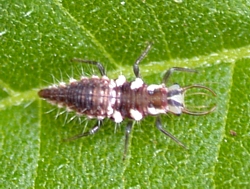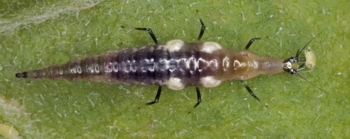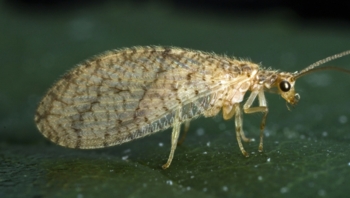|
|
ARTHROPODS:
Insects»
Spiders»
Centipedes»
Millipedes»
Sowbugs»
Harvestmen»
Mites
& Ticks»
Scorpions»
Identification
Tips»
About
the Critter Files»
Links» |
|
|
|
 |
LACEWINGS
Critter
Files/Insects/Lacewings
By Blake Newton
University of Kentucky Department of Entomology |
| |
|
| Common
Kentucky Lacewings: |
| |
| TAXONOMY |
KINGDOM: Animalia
| PHYLUM: Arthropoda | CLASS: Insecta | ORDER:Neuroptera |
| |
WHAT
IS A LACEWING?
LIFE CYCLE
ECOLOGY
PEST STATUS
COMMON KENTUCKY LACEWINGS
COLLECTING & PHOTOGRAPHY
LACEWING FACTS
MYTHS, LEGENDS, AND FOLKLORE |
| |
| WHAT
IS A LACEWING? |
|
Adult lacewings have
2 pairs of wings and chewing mouthparts. They also have long,
thin bodies, and resemble dragonflies, but lacewings hold their
wings over their backs when they are not flying: dragonflies are
unable to fold their wings over their bodies. As the name
suggests, the wings of these insects are lace-like, with a dense
network of veins and cross veins. There are two common families of lacewings
in Kentucky: green lacewings (family Chrysopidae) and brown lacewings
(family Hemerobiidae). Other than color, they are very similar
in appearance. Green and brown lacewings are in the order
Neuroptera, which also include snakeflies, mantidflies, and other
insects. Like all insects, lacewings have 3 body parts, 1
pair of antennae, and 6 legs.
Lacewing larvae resemble
small caterpillars, but move more quickly, have longer legs, and
have long, sickle-shaped mouthparts. |
|
| SIZE:
Body length of adult lacewings up to 1" long, larvae up to 1/2". |
| |
| LIFE
CYCLE |
|
Lacewings
have complete metamorphosis. After hatching from distinct,
stalk-shaped eggs in late spring, the predatory larvae feed and
grow for a few weeks, molting several times until they are ready
for pupation. In the summer, the pupal stage lasts for a short
time, allowing the adults to emerge, feed, mate, and produce additional
generations of eggs before the end of the season. Pupae formed
in fall will overwinter, with adults emerging and mating in the
spring.
|
| |
 Green lacewing eggs (R. Bessin, 2000)
Green lacewing eggs (R. Bessin, 2000) |
 Green lacewing larva (B. Newton, 2003)
Green lacewing larva (B. Newton, 2003) |
| |
| ECOLOGY |
|
|
Larval green and brown
lacewings are fast-moving predators that patrol plants for aphids,
insect eggs, and other arthropod prey. They are voracious,
feeding whenever they find food. Larvae use their sickle-like
mandibles to suck fluids from their prey. Lacewing larvae
are sometimes eaten by other creatures, such as spiders, lady
beetles, and larger lacewings. |
 Green lacewing
larva preying on aphids.
Green lacewing
larva preying on aphids.
(Image courtesy University of Florida) |
| |
| Some lacewing larvae cover themselves with debris or with the remains
of their prey as a way to camouflage themselves from larger predators. |
| |
| Green and
brown lacewing adults are also predators and feed on the same prey
as the larvae: aphids, insect eggs, etc. Because lacewing larvae
are well-known for feeding on aphids, they are often called "aphid
lions." Lacewing adults do not fly very well, and are often
eaten by flying predators such as birds and dragonflies. |
| |
| PEST
STATUS |
|
Because
they feed on aphids and other pests, lacewings are beneficial insects.
They do not bite or sting. |
| |
| COMMON
KENTUCKY LACEWINGS |
|
|
GREEN
LACEWINGS
FAMILY: Chrysopidae
| GENUS: Chrysoperla and others
Green lacewings are the
most commonly encountered lacewings in Kentucky. Many of the
common green lacewings found in Kentucky, such as the one pictured below,
are in the Chrysoperla genus. They are
typically about 1" long with lime-green bodies and golden heads. |
| |
 Green lacewing
adult in the Chrysoperla genus (R. Bessin, 2000)
Green lacewing
adult in the Chrysoperla genus (R. Bessin, 2000) |
|
|
|
BROWN
LACEWINGS
FAMILY: Hemerobiidae
Brown lacewing adults
look and behave very much like green lacewing adults, but they are
tan in color and are not encountered as often as green lacewings. Note that we had previously reported here that brown lace wing larvae are sometimes called "trashbugs" and that they carry debris on their bodies. This was based on old information, and is probably not true (although the larvae of green lacewings will carry debris). |
| |
 Brown Lacewing Larva (Photo David Cappaert, Michigan State University, courtesy Bugwood network)
Brown Lacewing Larva (Photo David Cappaert, Michigan State University, courtesy Bugwood network) |
| |
 Brown Lacewing Adult (Photo David Cappaert, Michigan State University, courtesy Bugwood network)
Brown Lacewing Adult (Photo David Cappaert, Michigan State University, courtesy Bugwood network) |
|
| |
| COLLECTING
& PHOTOGRAPHY |
|
During certain times
of the year, especially early and late summer, green lacewing adults
are abundant and easy to find in Kentucky. Look in field crops,
fence rows, and other places where weeds and shrubs are growing.
Green lacewings do not fly very fast, so they are often easy to
capture. They will also remain still for a few moments while they
are eating, providing a good opportunity for a photograph. Green
lacewing larvae are common all summer long. They can be found on
weeds and on crop plants like corn and soybean where they patrol
for aphids. When collected, lacewing larvae (like all insect larvae)
should be preserved in alcohol.
Brown lacewings are found
in the same habitats as green lacewings, but they are less commonly encountered. Remember that some lacewing larvae are camouflaged in debris and can be difficult to spot.
|
| |
| LACEWING
FACTS |
|
Green lacewings are
beneficial insects that help farmers by eating aphids and other
pests. Read more about how scientists and farmers at the University
of Wisconsin are finding out better ways to use lacewings as biological
control agents:
http://www.entomology.wisc.edu/mbcn/kyf103.html |
| |
| MYTHS
- LEGENDS - FOLKLORE |
|
Have you heard any
myths, legends, or folklore about lacewings? If so, let us
know. |
| |
Original document: 25 May 2004
Last updated: 21 Apr 2008
Photos courtesy R.
Bessin and B. Newton, University of Kentuck, except Lacewing Larva w/Aphids:
University of Florida; used with permission.
The Kentucky Critter
Files are maintained by Blake Newton, Department of Entomology, University
of Kentucky.
Contact: blaken@uky.edu
|
|

